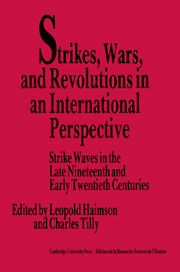 Strikes, Wars, and Revolutions in an International Perspective
Strikes, Wars, and Revolutions in an International Perspective Book contents
- Frontmatter
- Contents
- List of contributors
- Preface
- Part I Introductions
- 1 Theories and realities
- 2 The historical setting in Russia and the West
- Part II Models and realities
- Part III Workers in metal-processing enterprises in comparative perspective
- Part IV The effects of short-term variation
- Part V Conclusion
2 - The historical setting in Russia and the West
Published online by Cambridge University Press: 25 March 2010
- Frontmatter
- Contents
- List of contributors
- Preface
- Part I Introductions
- 1 Theories and realities
- 2 The historical setting in Russia and the West
- Part II Models and realities
- Part III Workers in metal-processing enterprises in comparative perspective
- Part IV The effects of short-term variation
- Part V Conclusion
Summary
The role of strike actions as weapons in the struggle of industrial workers for power and autonomy in the workplace and also in the polity as a whole, and the interrelationships to be discerned between the various aspects of this labor struggle, have reemerged in recent years as a major theme in historical studies of labor unrest and of workers' movements. Yet, however obvious the relationship of strikes to politics appears – particularly when one focuses attention on major strike waves, which challenge most openly and directly the whole structure of power and authority governing workers' conditions of life and work – the processes underlying the outbreak, the unfolding, and the eventual outcomes of such major strike waves are by no means easy to establish, especially when one considers them in a comparative historical perspective.
To what extent and in what respects do major waves of labor unrest expose long-standing fissures in the societies in which they break out? To what degree do they in turn contribute to the widening, if not to the opening, of these fissures? What significance is to be assigned, in this connection, to the role of relatively long-term structural processes of change in the conditions of life and work of various strata of industrial workers, and their cumulative effects on these workers' mentalities, attitudes, and patterns of collective action? What role is to be attributed, on the other hand, to historically more circumscribed political and economic conjunctures, and to specific historical events?
- Type
- Chapter
- Information
- Strikes, Wars, and Revolutions in an International PerspectiveStrike Waves in the Late Nineteenth and Early Twentieth Centuries, pp. 18 - 32Publisher: Cambridge University PressPrint publication year: 1989
- 1
- Cited by


